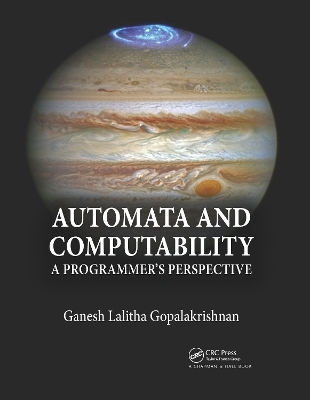
Automata and Computability
A Programmer's Perspective
Seiten
2020
Chapman & Hall/CRC (Verlag)
978-0-367-65654-6 (ISBN)
Chapman & Hall/CRC (Verlag)
978-0-367-65654-6 (ISBN)
- Titel z.Zt. nicht lieferbar
- Versandkostenfrei
- Auch auf Rechnung
- Artikel merken
This class-tested textbook provides a comprehensive and accessible introduction to the theory of automata and computation. It incorporates modern/handy ideas, such as derivative-based parsing and a Lambda reducer showing the universality of Lambda calculus.
Automata and Computability is a class-tested textbook which provides a comprehensive and accessible introduction to the theory of automata and computation. The author uses illustrations, engaging examples, and historical remarks to make the material interesting and relevant for students. It incorporates modern/handy ideas, such as derivative-based parsing and a Lambda reducer showing the universality of Lambda calculus. The book also shows how to sculpt automata by making the regular language conversion pipeline available through a simple command interface. A Jupyter notebook will accompany the book to feature code, YouTube videos, and other supplements to assist instructors and students
Features
Uses illustrations, engaging examples, and historical remarks to make the material accessible
Incorporates modern/handy ideas, such as derivative-based parsing and a Lambda reducer showing the universality of Lambda calculus
Shows how to "sculpt" automata by making the regular language conversion pipeline available through simple command interface
Uses a mini functional programming (FP) notation consisting of lambdas, maps, filters, and set comprehension (supported in Python) to convey math through PL constructs that are succinct and resemble math
Provides all concepts are encoded in a compact Functional Programming code that will tesselate with Latex markup and Jupyter widgets in a document that will accompany the books. Students can run code effortlessly.
All the code can be accessed here.
Automata and Computability is a class-tested textbook which provides a comprehensive and accessible introduction to the theory of automata and computation. The author uses illustrations, engaging examples, and historical remarks to make the material interesting and relevant for students. It incorporates modern/handy ideas, such as derivative-based parsing and a Lambda reducer showing the universality of Lambda calculus. The book also shows how to sculpt automata by making the regular language conversion pipeline available through a simple command interface. A Jupyter notebook will accompany the book to feature code, YouTube videos, and other supplements to assist instructors and students
Features
Uses illustrations, engaging examples, and historical remarks to make the material accessible
Incorporates modern/handy ideas, such as derivative-based parsing and a Lambda reducer showing the universality of Lambda calculus
Shows how to "sculpt" automata by making the regular language conversion pipeline available through simple command interface
Uses a mini functional programming (FP) notation consisting of lambdas, maps, filters, and set comprehension (supported in Python) to convey math through PL constructs that are succinct and resemble math
Provides all concepts are encoded in a compact Functional Programming code that will tesselate with Latex markup and Jupyter widgets in a document that will accompany the books. Students can run code effortlessly.
All the code can be accessed here.
Ganesh Gopalakrishnan is a professor in the Computer Science Department at the University of Utah.
I Foundations
1 What Machines Think
2 Defining Languages: Patterns in Sets of Strings
3 Kleene Star: Basic Method of defining Repetitious Patterns
II Machines
4 Basics of DFAs
5 Designing DFA
6 Operations on DFA
7 Nondeterministic Finite Automata
8 Regular Expressions and NFA
9 NFA to RE conversion
10 Derivative-based Regular Expression Matching
11 Context-Free Languages and Grammars
12 Pushdown Automata
13 Turing Machines
III Concepts
14 Interplay Between Formal Languages
15 Post Correspondence, and Other Undecidability Proofs
16 NP-Completeness
17 Binary Decision Diagrams as Minimal DFA
18 Computability using Lambdas
| Erscheinungsdatum | 01.10.2020 |
|---|---|
| Sprache | englisch |
| Maße | 210 x 280 mm |
| Gewicht | 640 g |
| Themenwelt | Informatik ► Software Entwicklung ► User Interfaces (HCI) |
| Informatik ► Theorie / Studium ► Algorithmen | |
| Mathematik / Informatik ► Mathematik | |
| ISBN-10 | 0-367-65654-X / 036765654X |
| ISBN-13 | 978-0-367-65654-6 / 9780367656546 |
| Zustand | Neuware |
| Haben Sie eine Frage zum Produkt? |
Mehr entdecken
aus dem Bereich
aus dem Bereich
Aus- und Weiterbildung nach iSAQB-Standard zum Certified Professional …
Buch | Hardcover (2023)
dpunkt Verlag
CHF 48,85
Lean UX und Design Thinking: Teambasierte Entwicklung …
Buch | Hardcover (2022)
dpunkt (Verlag)
CHF 48,85
Wissensverarbeitung - Neuronale Netze
Buch | Hardcover (2023)
Carl Hanser (Verlag)
CHF 48,95


